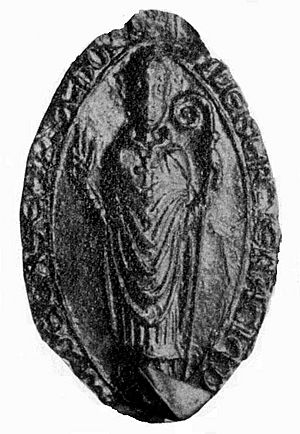Gilbert of Glenluce facts for kids
Quick facts for kids Gilbert |
|
|---|---|
| Bishop of Galloway | |

Bishop Gilbert's seal
|
|
| Church | Roman Catholic Church |
| See | Diocese of Galloway |
| In Office | 1235–1253 |
| Predecessor | Walter |
| Successor | Henry of Holyrood |
| Orders | |
| Consecration | 2 September 1235 |
| Personal details | |
| Born | Probably late 12th century unknown |
| Died | 1253 |
| Previous post | Abbot of Glenluce (resigned 1233) |
Gilbert was an important church leader in the 13th century. He was a Cistercian monk, an abbot (head of a monastery), and later a bishop. He lived in Scotland during a time when the country was still forming its identity.
We first hear about Gilbert in 1233. At that time, he was the Abbot of Glenluce, which means he was in charge of Glenluce Abbey in Galloway, Scotland. The Chronicle of Melrose, a historical record, says that Gilbert gave up his role as abbot. He then became a simple brother at Melrose Abbey. It's not clear why he made this change. After moving to Melrose, Gilbert became the Master of the Novices. This meant he taught new monks joining the abbey.
Contents
Becoming Bishop of Galloway
In 1235, Gilbert was chosen to be the new Bishop of Galloway. This happened on February 25th. The Melrose Chronicle states that "the whole people and the clergy on Galloway" elected him. However, there was a problem. The Prior of Whithorn and the monks of Whithorn Priory believed they had the right to choose the bishop. They did not agree with Gilbert's election.
A Disputed Election
The monks of Whithorn Priory chose their own candidate, a man named Odo Ydonc. He was also a church leader and had been the Abbot of Dercongal. This created a conflict over who should be the true Bishop of Galloway.
King Alexander II of Scotland supported Gilbert's election. He officially approved it on April 23rd. Historians believe King Alexander wanted Gilbert to be bishop to help the Scottish crown gain more control over Galloway. This area had recently been added to Scotland.
Papal Investigation
The dispute over the bishop's election went all the way to the Pope. Both sides appealed to the Archbishop of York and Pope Gregory IX. The monks argued that Gilbert's election was not legal.
Pope Gregory IX started an investigation on June 9th. He asked three bishops to look into Odo's election. If they found it to be legal, they were told to make Odo bishop. They were also told to make Gilbert return anything he had taken. However, the results of this investigation are not known. Gilbert managed to keep his position as bishop. He was officially consecrated (made a bishop) by Archbishop Walter de Gray in York on September 2nd, 1235.
Gilbert's Time as Bishop
Gilbert served as Bishop of Galloway for twelve years. During this time, he made some important decisions for the church.
Church Activities
He confirmed a gift of the church of Sorbie to Dryburgh Abbey. This gift had been made by the previous bishop, Walter. Gilbert combined two churches in Sorbie into one. He also gave the church of Borgue to Dryburgh Abbey. He made sure there was a vicar (a local priest) to serve the people there.
Gilbert also worked in England, especially in the Bishopric of Durham. When there was no bishop in Durham, Gilbert would step in. He performed duties like granting indulgences (special church blessings) and dedicating altars.
Gilbert died in 1253. His death was recorded in both the Melrose Chronicle and the Lanercost Chronicle.

